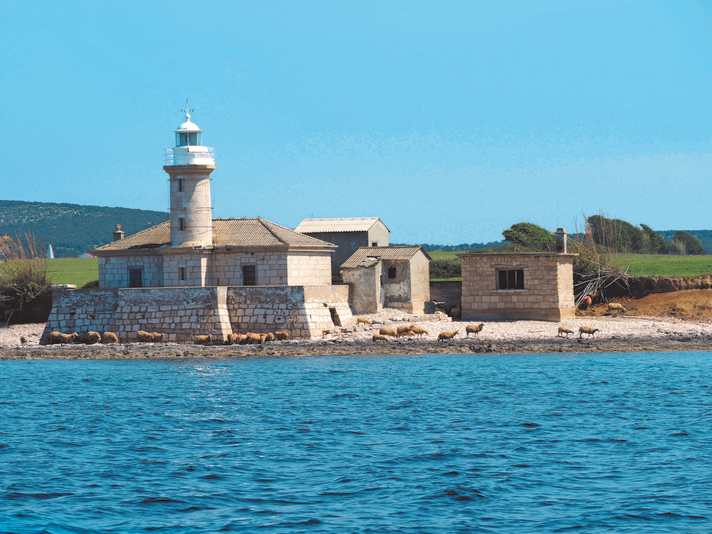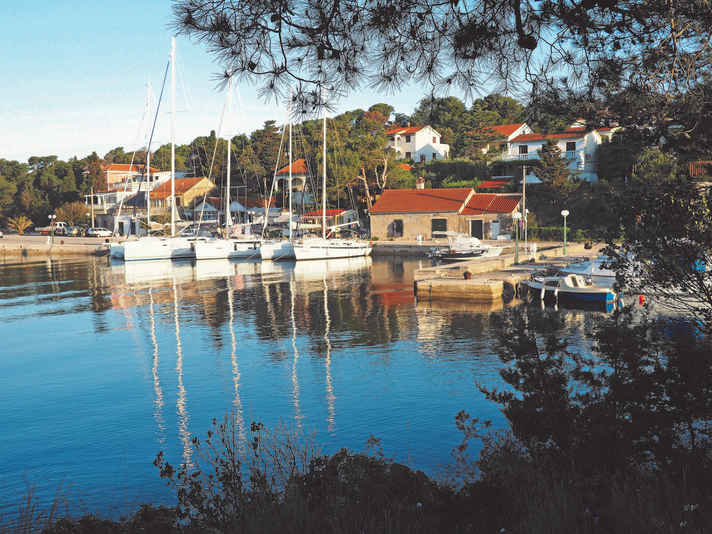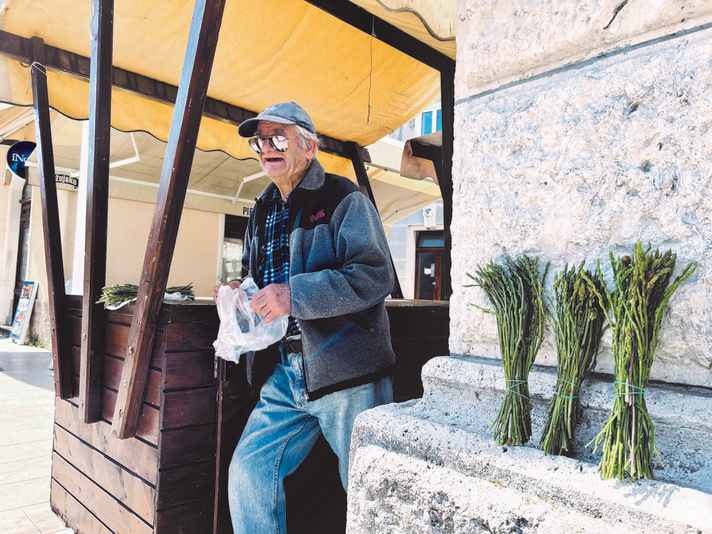Croatia: The tempting islands of Kvarner

Arrival Saturday morning. Big day in the Marina Veruda in Pula. Especially at the jetty with the Pitter yachts. It's as if you've landed in a shipwash. Everywhere is being cleaned and repaired, while the charter crews arrive in large numbers at the same time. Many of them come by car from nearby Austria or southern Germany, which is not far away. Once through instead of flying over the Alps.






After arrival, we check in. In our case on a new Jeanneau 410 called "Kalumina" - the owner's version, as feudal as the ship is equipped. There is even an electric winch for the main engine next to the companionway. And on the panel is the password for the on-board Wi-Fi. But is it really so good that the Internet is becoming increasingly dense? As someone who grew up with analogue technology, I'm not too happy about this. The skipper and patchwork dad in me is unsure whether I should even tell the two new matrons. I don't want them to end up surfing the internet more than the waves.

We want to head for the outer islands of Kvarner Bay, the little stepsisters of the larger islands of Krk, Cres and Rab, so to speak. And find out what they have to offer - whether in the end less attraction means more relaxation, or whether it is too quiet there in the low season. Last but not least, we want to see whether there are more moorings and mooring buoys to choose from.
Departure for the Kvarner
In the afternoon, we quickly head out. Just two bays further on. The prospect of a quiet bay and a night at anchor is too tempting compared to the ability of one or two charter crews to party at the jetty. It's not only in Croatia that there's always a good chance that at least one of the 20 or 30 freshly chartered crews won't find an end but will still find a bottle.
We also have an appointment in Banjole Bay with an old acquaintance, the berth charterer Wolfgang Stuis. He is a Croatian by choice, lives with a view of the bay and runs two boats here himself. Who, if not him, would be better and more willing to act as an area coach? The Kvarner Bay is his workplace, so to speak.
"Look forward to it, early season is the best," Wolfgang says in the restaurant in his home bay in the evening. Between the round and very good pizzas lies the square menu. Wolfgang's finger wanders here and there. A pencil is needed. At the end of the briefing it is clear: as is so often the case, there are more islands and bays than can be covered in a week. Hence the offer that we can call and enquire at any time - for remote control.
Beautiful Sunday sailing in Croatia
The next day we leave Banjole. Anchor up. And setting sail for beginners, ladylike with an electric winch instead of a crank. Or should we have kept quiet about what the button below the winch is for? As soon as the sheets are up, we're sailing southwards at a sporty 7.5 knots. Not bad for a start! Everything fits right away: wind, wind direction, sun, temperature. Bikini-worthy gusts. We therefore leave Unije, the first possible island on our course, to the left or to port. It's going far too well at the moment. Nice Sunday sailing. We drop anchor ten miles later in the bay of Susak. This charming island lies in the middle of the Croatian Adriatic, part of the Losinj archipelago. It consists mainly of sand and accordingly boasts some of the most beautiful sandy beaches in the country, which, with a little goodwill and imagination, even convey a touch of Caribbean feeling.

To protect their car-free island from erosion, the inhabitants have planted reeds around the coast, which makes a walk from the anchorage bay to the village very attractive. Today, just under 150 people still live on Susak. Most of them emigrated to the USA in the 1960s. Unfortunately, the former emigrants only return at the end of July to celebrate the traditional "Day of the Emigrants" every year. In the pre-season, the place therefore appears somewhat deserted, as expected.
The next morning we cross over to Mali Losinj. This beautiful town lies at the head of Augustus Bay. Mali Losinj was an important seafaring and trading centre in the 19th century due to its good location. Over the centuries, it has grown from a small village to a small town with over 7,000 inhabitants. It is now one of the most popular holiday destinations in the entire Kvarner Bay.
Day trippers can moor at the public pier for a stopover and immediately stumble into one of the numerous cafés. Life in the town pulsates from the harbour up the one-way street "Ulica". On the menus of the konobas, the typical local restaurants, you will find many local Mediterranean dishes flavoured with the herbs that are so typical of Losinj. To earn a bite to eat, we recommend a walk up the stone steps to the parish church of Mali Losinj. The church square offers a panoramic view of the town and the sea.
Plenty of space in the pre-season
The temperatures rise in proportion to the position of the sun. Time to cast off and look for a bay to swim in, which is never particularly difficult in Croatia. Unfortunately, there is no wind, so we decide in favour of the nearest one: Krivica Bay. Only two of the many mooring buoys, which are almost artfully laid out in rows, are occupied in May. An installation in which the yellow of the buoys floats on the total turquoise. The colour of the water is so compelling that it even tempts the girls to jump dry. With the realisation that what shines turquoise does not necessarily have to be warm in May.
Towards the afternoon, the thermals fire up the turbines. On the course to Ilovik we have to cross a little for the first time. But the conditions remain moderate. The deck doesn't get wet. The wind then picks up in the Ilovik channel. This jet effect makes the subsequent Muring manoeuvre the first challenge. But the effort is worth it. Ilovik - also known as Flower Island - is the southernmost inhabited island in the Losinj archipelago. Around 170 inhabitants live in the fishing village of the same name.
The islands are rich in Roman remains, with the remains of walls, a sarcophagus and an underwater archaeological site. The first Croatian settlers arrived on the island at the end of the 18th century. Their descendants still make a living from wine-growing and fishing, sheep farming and tourism.
For a fee of 20 kuna (approx. 3 euros), you can be shuttled ashore. Which is gratefully accepted, especially as our outboard motor is quite oversized for the size of the dinghy. So much so that one of the girls even thinks it's the main drive. And why is it actually hanging on the railing? You're allowed to smile, but don't sneer now.

The island of Ilovik is quickly explored and is also still very quiet in the low season. The liveliest place is the terrace of the "Amico" restaurant with a view of the yachts against a magnificent backdrop. The palm-fringed remains of a Benedictine monastery can be found on the island of Sveti Petar opposite. Enjoy an aperitif and good food: There could hardly be a better photo backdrop and reward for a botched Muring manoeuvre.
Next day - new island. We sail to Ist in perfect conditions. The pier would be ideal for a day stopover. But the fact that there is not a single yacht alongside makes us suspicious. To avoid stress, we anchor on the finest sand as a precaution. It would be a shame if the ferry came and blew its horn just as we were going ashore. And lo and behold, as soon as you take a seat in a café and look towards the mast for the first time, the ferry comes roaring round the corner.
The clocks tick differently on Ist
The limestone island of Ist is different. It is a special excursion and holiday destination for Croatians away from the otherwise popular holiday resorts. There are no cars here either, the island is made for sailors and nature lovers. The travel guide says that even bicycles are not allowed during the summer season, so you can literally feel the silence. The clocks definitely tick differently here - or not at all.
If the local supermarket is not open, you wait patiently in front of it. Surrounded by more or less well-groomed-looking cats who obviously also want to shop. Next door, a restaurant heats up the barbecue for the evening. Cevapcici skewers are being prepared in the kitchen.
Later in the day, it turns out that the older part of the crew wants to stay, the younger part wants to experience something. The wiser gives in. After all, there's nothing to be said against a sporty blow in the evening breeze, one island away to Molat.

Molat is characterised by unspoilt flora, mainly consisting of green spruce and pine forests, scrub-like maquis and numerous secluded, rocky bays that are best explored by boat. The girls protest. They want proper sanitary facilities.
No problem. Or is it? Molat's harbour has the best wash houses far and wide, but it says somewhere that you should be careful with the mooring lines on the pier. There is a warning that they are not necessarily at the bottom, but rather a job creation measure for the local diver. In other words: near and at the height of the screws. Trust, look who.
There's only one thing to do: reverse at creep speed and keep disengaging the clutch. As if you were parking by ear. No problem when there's no wind. Let the others think what they want. Even if it turns out to be a false alarm: False alarm. There's no sign of the lines being too tight, at least in the early season. Perhaps the water is still too cold for the diver.
Provisioning is sometimes a matter of luck
Unfortunately, the restaurants are already closed, but you can stop off at his house, says the harbour master. Fresh fish on the table. Sounds good, but apparently better than it tastes, as the friendly neighbouring crew tell us. The brief review sounds something like this: "Well, it's pretty expensive." So it's better to have an emergency noodle on board after all.
The next morning, we hike to the other side of the island to buy bread rolls. A shop could hardly be more charming. Unfortunately, the selection looks pretty select. There is water and bread. And the luxury of a Nespresso machine. However, if you order a cappuccino, the friendly shop owner first has to read the instructions on how to use his machine. You feel like you're far away from Europe. But it's also somehow touching that something like this still exists.
Molat is the southernmost point of this trip. It was clear that we wouldn't be able to visit all the islands in a week. Between Olib and Silba, we decide in favour of the latter, the sailor's island. Although there is also a robbery story about Silba. There's a warning about a notorious landlord who quite ruthlessly chases away all sailors from the harbour basin who don't stop at his place. However, when we arrive, there is no sign of the man and the restaurant is closed.

What you can see from afar, however, is Silba's landmark: a hexagonal "love tower". Allegedly built by a captain so that his wife could wave longingly at him from afar. And indeed, the panoramic view replaces any drone. However, the spiral staircase has an integrated diet function. It is designed to be as narrow as if the captain had once wanted to force his wife to stay in bed while he was away.
The last night belongs to the youth. No need for a disco, but a little stroll in the evening, a nice drink, a good restaurant, that's fine. Just that holiday feeling. We call at Mali Losinj again. The busy harbour master beckons to us from afar. No chance of mooring at the public pier. Although there would be enough space. The man is holding his credit card reader in one hand. With the other, he takes the stern lines. The money is collected even before the electricity is switched on and the ship is cleared. What the heck, Mali Losinj is definitely worth a second stop.
More Mediterranean flair is hardly possible. In the end, you realise: the mix makes the territory. This also applies to the outposts of the Kvarner Bay, the beauties from the second row. All sailing needs are catered for here - and new ones are awakened: to come back soon.
Tips for sailing in Kvarner

- Banjole BayNot spectacular, but ideal for spending a quiet night at anchor and leaving the stress of travelling behind with a first swim in the sea. There is a pizzeria a little way up the road from the dinghy mooring that is well worth the short walk.
- Mali LosinjIt's a must because it has the most Mediterranean flair: a palm-lined promenade, cafés and restaurants in every price range. We went to the "Konoba Hadjuk", which is also popular with the locals.
- IlovikYou can grab a buoy in the channel between the islands and be ferried to the restaurant in the evening if you wish. Or, if you're lucky, you might get a spot in the small harbour basin. Either way, the view from the terrace of the "Amico" restaurant (www.ilovik.hr) is fantastic.
- Island IsAlso known as Butterfly Island because of its shape when viewed from the air. There are more cats on the island than cars. Just the thing for people looking for deep relaxation.
- SilbaIt is said that negotiations are currently underway as to who will be allowed to manage the municipal harbour. In addition to the "Liebesturm" tower, there is an imposing church tower to marvel at. On the other side of the island, there is a nice breakfast café under tamarisk trees next to the ferry landing stage.
Precinct information
Charter
We were travelling on a Jeanneau Sun Odyssey 410 from Pitter-Yachting. The boat costs 1,400 euros a week in the low season and 4,050 euros a week in the high season. To book under www.pitter-yachting.com , telephone +43 3332 66 240, e-mail: info@pitter-yachting.com, or via the usual agencies.
Wind and weather
In summer, the Croatian coast enjoys a mild, Mediterranean climate. The typical summer wind is the Maestrale, which blows from the north-west at up to five Beaufort during the day and dies down in the evening. Normally, the Burin from the north-east, which sets in at night, then takes over on the northern Adriatic until daybreak. The changeable interplay of both winds is an indication of persistently fine weather. Less favourable is the Jugo, a humid wind from the south, which brings waves and precipitation. And then there is the notorious bora, which can occur at any time. A typical sign is a roll of clouds over the coastal mountains. In the area of Kvarner Bay, the assault-like wind from the mountains can reach gale force even in summer. The duration of this attack ranges from a few hours to two days. The good news is that the further you are from the mainland, the weaker the gusts. The Croatian forecasts predict the bora very well ( www.meteo.hr ).
Navigation and seamanship
The area is suitable for beginners, the distances are manageable. And the stages can be varied according to your mood. The water is deep almost everywhere, right up to the coast. In principle, you can navigate by sight. However, the passage between the lighthouse on the island of Porer and the cape can be very uncomfortable in Jugo. Coming from the north, it is a good idea not to sail too close to land and to keep the lighthouse on the port side. A steep sea quickly builds up here. In the event of a bora or jugo, look for a safe berth in good time and weather off in the harbour of Mali Losinj, for example.
Charts and literature
- B. Müller/J. Straßburger: "Küstenhandbuch Kroatien und Slowenien", 29.90 euros; B. Müller: "Kroatische Küste, Kvarner Bucht", 19.90 euros, both published by Edition Maritim.
- "Croatia: 888 harbours and bays", Karl-Heinz Beständig, self-published, 29.90 euros.
- DK sports boat chart set "Adria 1" (including digital chart), 59.90 euros, www.delius-klasing.de.

